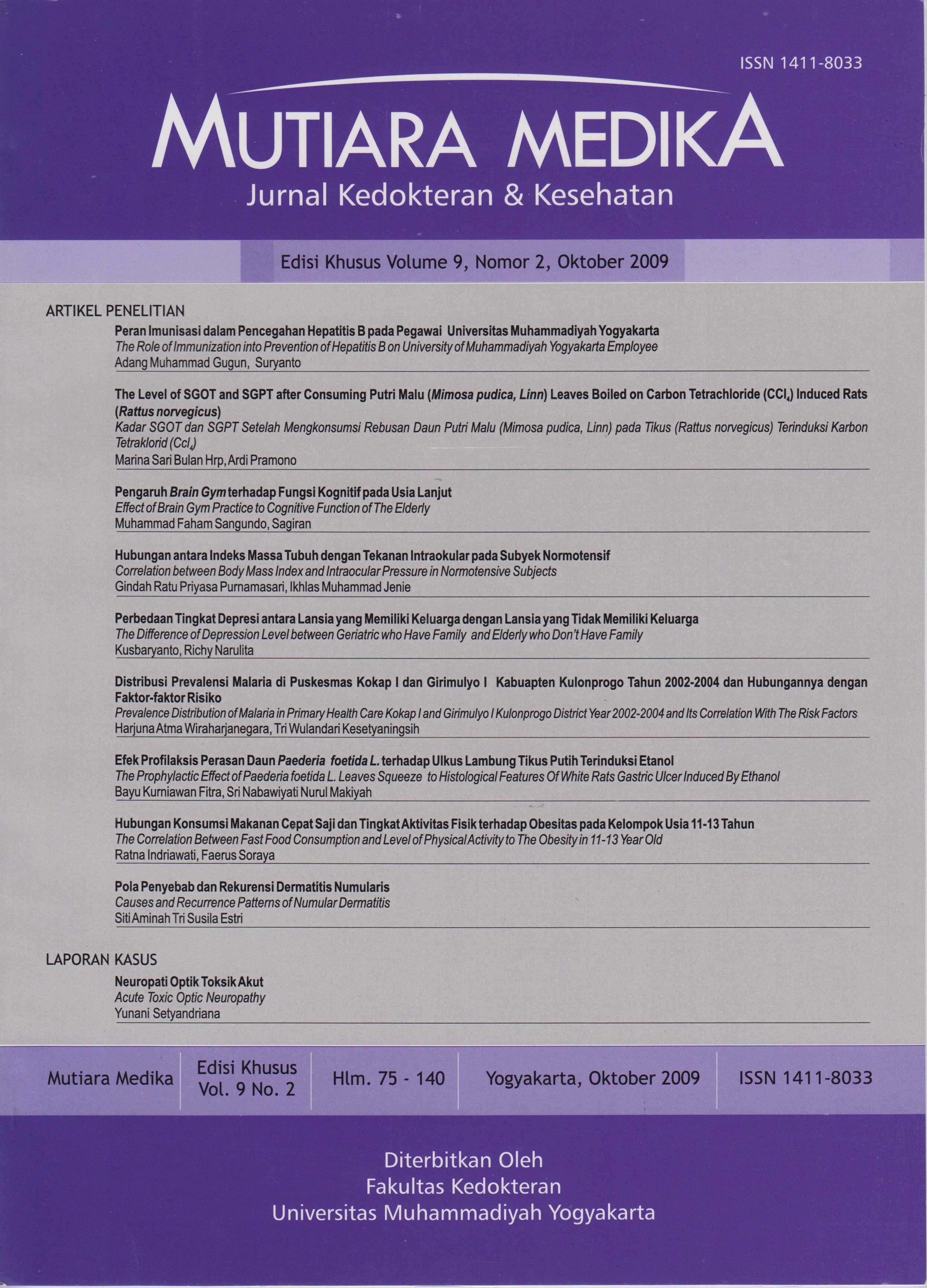Neuropati Optik Toksik Akut
DOI:
https://doi.org/10.18196/mmjkk.v9i2%20(s).1617Keywords:
buta, defek lapang pandang, neuropati optik toksik akut, acute toxic optic neuropathy, visual loss, visual field defectAbstract
The aim of the study was to report a case of acute toxic optic neuropathy. A case report of a 29 years old female with acute visual loss in both eyes. There was history of taking multiple drugs about 4 days while in the hospital. We performed visual acuities examination, light projection, color perception, funduscopy, and visual field examinations. The visual acuities were 1/300 on both eyes with bad color perceptions, the other examination were normal. Visual field examination was performed on the third day when the visual acuities were improved, showing severe depression on the both eyes and diagnosed acute toxic optic neuropathy. She is given neurotropic injection once daily, neutotropic tablet twice daily, and acetazolamide tablet 3 times daily. Retrobulber dexamethason injection on second day for 5 days, and continued with dexamethason tablet 1mg four times daily. The patients was consulted to neurology, ENT, internist, and oral medicine department. The visual acuity became better 3/60 in the both eyes on the third days, on the seventh days on the right eye 5/60 and the left eye 4/60. One week later, the visual acuity became 6/12 on the right eye and 6/15 on the left eye, but there was color deficiency in both eyes. Visual field examination of both eyes showed improvement to be moderate depression. The treatment was continued and dexamethason was tapering off. Follow up in one month the visual acuity improved to be 6/7.5 on the right eye and 6/8.5 on the left eye, although there was still green color blind with one eye. Visual field showed mild depression. Concluded a case of acute toxic optic neuropathy treated with steroid injection and orally, and neurotropic agents, there was a good result although not fully recovery.
Tujuan penulisan makalah ini adalah untuk melaporkan laporan kasus yaitu neuropati optic toksik akut. Dilaporkan kasus seorang wanita 29 tahun buta mendadak kedua matanya. Empat hari sebelum datang ke rumah sakit minum beberapa obat. Dilakukan pemeriksaan visus, proyeksi cahaya, persepsi warna, funduskopi, dan lapang pandang. Visus kedua mata 1/300 dengan persepsi warna buruk, pemeriksaan lain normal. Pemeriksaan lapang pandang dilakukan hari ke-3 saat visusnya mulai membaik. Hasilnya menunjukkan depresi berat kedua mata dan didiagnosis neuropati optic toksik akut. Diberikan terapi neurotropik injeksi sekali sehari, neurotropik tablet 2x sehari, dan asetazolamide tablet 3x sehari. Dexamethason injeksi retrobulber diberikan hari kedua selama 5 hari, dilanjutkan dengan dexamethason tablet 1mg 4x sehari. Pasien dikonsulkan ke neurologi, THT, penyakit dalam, dan dokter gigi. Visus hari ketiga membaik menjadi 3/60 pada kedua mata, hari ke- 7 menjadi 5/60 mata kanan dan 4/60 mata kiri, namun didapatkan buta warna pada kedua mata. Seminggu kemudian visus membaik menjadi 6/12 mata kanan dan 6/15 mata kiri. Lapang pandang menunjukkan depresi sedang. Terapi diteruskan dengan dexamethason tablet diturunkan dosisnya. Follow up 1 bulan kemudian menunjukkan perbaikan dengan visus 6/7.5 mata kanan dan 6/8.5 mata kiri, namun masih terdapat buta warna hijau. Pemeriksaan lapang pandang menunjukkan depresi ringan. Disimpulkan bahwa kasus neuropati optic toksik akut diterapi dengan steroid injeksi dan oral serta obat neurotropik, didapatkan perbaikan kondisi meskipun tidak sempurna.
References
Kline LB, Bajandas FJ. Neuro-Ophthalmology Review Manual, 5th ed. Slack Incorporated, USA. 2001.
Bruce J. Lecture notes on Ophthalmology. 9th ed. Blackwell Science Ltd. English, 2003:151-53.
Kanski JJ. Clinical Ophthalmology. 3th edition. London: Butterworth-Heinemann, 1994:14:457.
Newman SA. Basic and Clinical Science Course section 5 Neuro¬Ophthalmology. San Francisco, California, 2003;4:166-68.
Bern C, Philen RM, Freeman D, et al. Epidemic Optic neuropathy in Cuba- Clinical characterization and risk factors. The New England Journal of Medicine 1995;2:1176-82.
Albert DM, Jakobiec FA. Principles and Practice of Ophthalmology, vol 4. WB Saunders Company, 1994;205:2599- 2603.
Miller NR, Newman NJ. The Essentials: Walsh and Hoyt’s Clinical Neuro-Ophthalmology 5th ed, Lippincott Williams and Wilkins, Pensylvania, USA, 1999;10:290-302.
Chris H. Disorders of The Visual Pathway: from the optic disc to the visual cortex; http.www.optometry.co.uk.
Berck RW. Optic Neuritis treatment trial one year follow up result. Arch Ophthalmology J, 1993;111:773-5.
Farris. Bilateral post infectious optic neuritis and antravenous therapy in children. Ophthalmology J, 1990;97:339-45.
Downloads
Published
Issue
Section
License
Copyright
Authors retain copyright and grant Mutiara Medika: Jurnal Kedokteran dan Kesehatan (MMJKK) the right of first publication with the work simultaneously licensed under an Attribution 4.0 International (CC BY 4.0) that allows others to remix, adapt and build upon the work with an acknowledgment of the work's authorship and of the initial publication in Mutiara Medika: Jurnal Kedokteran dan Kesehatan (MMJKK).
Authors are permitted to copy and redistribute the journal's published version of the work (e.g., post it to an institutional repository or publish it in a book), with an acknowledgment of its initial publication in Mutiara Medika: Jurnal Kedokteran dan Kesehatan (MMJKK).
License
Articles published in the Mutiara Medika: Jurnal Kedokteran dan Kesehatan (MMJKK) are licensed under an Attribution 4.0 International (CC BY 4.0) license. You are free to:
- Share — copy and redistribute the material in any medium or format.
- Adapt — remix, transform, and build upon the material for any purpose, even commercially.
This license is acceptable for Free Cultural Works. The licensor cannot revoke these freedoms as long as you follow the license terms. Under the following terms:
Attribution — You must give appropriate credit, provide a link to the license, and indicate if changes were made. You may do so in any reasonable manner, but not in any way that suggests the licensor endorses you or your use.
- No additional restrictions — You may not apply legal terms or technological measures that legally restrict others from doing anything the license permits.






